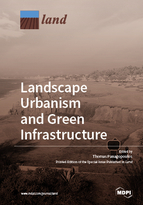Landscape Urbanism and Green Infrastructure
A special issue of Land (ISSN 2073-445X).
Deadline for manuscript submissions: closed (31 October 2018) | Viewed by 73884
Special Issue Editor
Interests: nature-based solutions; landscape restoration; sustainable development; climate change adaptation; green infrastructure; environmental justice; carbon neutral cities
Special Issues, Collections and Topics in MDPI journals
Special Issue Information
Dear Colleagues,
Urbanization presents one of the most urgent challenges of the 21st century. The global population is to reach almost 10 billion by 2050 and according to revised projections of the United Nations, the proportion that lives in urban areas is expected to increase from 54% to 70%. Meanwhile, unsustainable, non-resilient urbanization patterns have caused the degradation of ecosystems and their services.
Green infrastructure is a network of green (land) and blue (water) spaces designed and managed to deliver a wide range of ecosystem services that can improve environmental conditions and therefore citizens' health and quality of life. Restoring, rehabilitating and increasing connectivity between existing, modified and new green areas within cities and at the urban–rural interface is necessary to enhance city adaptive capacity to cope with the effects of changes and to enable ecosystems to deliver their services for more livable, healthier and resilient cities.
The underlying economic conditions and the need for urban growth due to the growing population have to include environmentally-sustainable policies in order to address the problem in accordance with a healthy environment. It is needed a paradigm shift towards restorative sustainability for new and existing urban areas, and multidisciplinary knowledge, leading to solutions that celebrate the richness of design creativity while enhancing users’ experience, comfort, health, wellbeing and satisfaction, and in harmony with urban and natural ecosystems, reconnecting users to nature.
In this Special Issue, we invite papers focusing on, but are not limited to, the following topics:
- Regeneration of declining post-industrial cities
- Nature-Based Solutions and benefits of re-naturing cities
- Biophilic design
- Sustainable urban development
- Landscape ecological urbanism
- Climate change adaptation and mitigation
- Creating green space through low-budget and upcycling strategies for positive use of waste materials
- Placemaking: strengthening the connection between people and the places they share
- Participatory approaches in re-designing and transforming public spaces to increase health and well-being in cities
- Environmental justice: Innovative urban design and planning to reduce health-related environmental burdens, foster equitable access for all to public spaces and promote sustainable urban mobility patterns
We encourage contributions that present successful cases of designing healthier, greener, resilient, regenerated cities, with better living conditions for all, reduced crime and security costs, improved air and water quality, enhanced human health and wellbeing, reduced health costs, improved mobility conditions, and increased social cohesion.
We encourage contributions that demonstrate successful cases of increasing city resilience to climate change and disaster risk reduction thanks to the implementation of green infrastructure (e.g. reduced flood risks, mitigated heat stress and water-related challenges).
Dr. Thomas Panagopoulos
Guest Editor
Manuscript Submission Information
Manuscripts should be submitted online at www.mdpi.com by registering and logging in to this website. Once you are registered, click here to go to the submission form. Manuscripts can be submitted until the deadline. All submissions that pass pre-check are peer-reviewed. Accepted papers will be published continuously in the journal (as soon as accepted) and will be listed together on the special issue website. Research articles, review articles as well as short communications are invited. For planned papers, a title and short abstract (about 100 words) can be sent to the Editorial Office for announcement on this website.
Submitted manuscripts should not have been published previously, nor be under consideration for publication elsewhere (except conference proceedings papers). All manuscripts are thoroughly refereed through a single-blind peer-review process. A guide for authors and other relevant information for submission of manuscripts is available on the Instructions for Authors page. Land is an international peer-reviewed open access monthly journal published by MDPI.
Please visit the Instructions for Authors page before submitting a manuscript. The Article Processing Charge (APC) for publication in this open access journal is 2600 CHF (Swiss Francs). Submitted papers should be well formatted and use good English. Authors may use MDPI's English editing service prior to publication or during author revisions.
Keywords
- Urban regeneration
- Post-Industrial redevelopment
- Nature-Based Solutions
- Re-naturing cities
- Biophilic design
- Landscape architecture
- Public participation
- Landscape reclamation
- Environmental justice
- Urban planning
- Well-being






